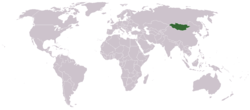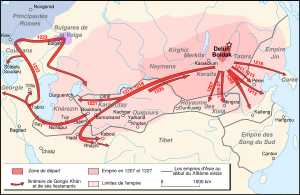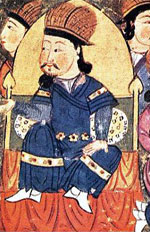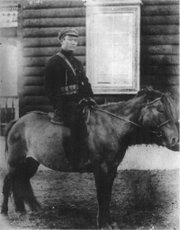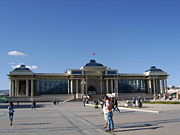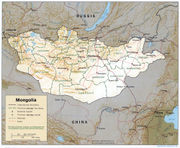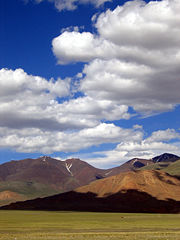Mongolia
2008/9 Schools Wikipedia Selection. Related subjects: Asia; Asian Countries
Монгол улс Mongol uls Mongolia
|
||||||
|---|---|---|---|---|---|---|
|
||||||
| Anthem: " Монгол улсын төрийн дуулал" National anthem of Mongolia |
||||||
|
|
||||||
| Capital (and largest city) |
Ulan Bator |
|||||
| Official languages | Mongolian | |||||
| Demonym | Mongolian |
|||||
| Government | Parliamentary republic | |||||
| - | President | Nambaryn Enkhbayar | ||||
| - | Prime Minister | Sanjaagiin Bayar | ||||
| Formation | ||||||
| - | National Foundation Day | 1206 | ||||
| - | Bogd Khanate of Mongolia | December 29, 1911 | ||||
| - | Mongolian People's Republic | November 24, 1924 | ||||
| - | Democratic Mongolia | February 12, 1992 | ||||
| Area | ||||||
| - | Total | 1,564,116 km² ( 19th) 603,909 sq mi |
||||
| - | Water (%) | 0.6 | ||||
| Population | ||||||
| - | July 2007 estimate | 2,951,786 ( 139th) | ||||
| - | 2000 census | 2,407,500 | ||||
| - | Density | 1.7/km² ( 238th) 4.4/sq mi |
||||
| GDP ( PPP) | 2007 estimate | |||||
| - | Total | $8.448 billion ( 143th) | ||||
| - | Per capita | $2,900 ( 130th) | ||||
| Gini (2002) | 32.8 (medium) | |||||
| HDI (2007) | ▲ 0.700 (medium) ( 114th) | |||||
| Currency | Tögrög ( MNT) |
|||||
| Time zone | ( UTC+7 to +8) | |||||
| Internet TLD | .mn | |||||
| Calling code | +976 | |||||
Mongolia (pronounced /mɒŋˈɡoʊliə/; Mongolian: Монгол улс , ![]() ) is a landlocked country in East- Central Asia. It borders Russia to the north and China to the south. Ulan Bator, the capital and largest city, is home to about 38% of the population. Mongolia's political system is a parliamentary republic.
) is a landlocked country in East- Central Asia. It borders Russia to the north and China to the south. Ulan Bator, the capital and largest city, is home to about 38% of the population. Mongolia's political system is a parliamentary republic.
At 1,564,116 square kilometres, Mongolia is the nineteenth largest, and the most sparsely populated independent country in the world with a population of around 2.9 million people. It is also the world's second-largest landlocked country after Kazakhstan. The country contains very little arable land, as much of its area is covered by arid and unproductive steppes, with mountains to the north and west and the Gobi Desert to the south. Approximately thirty percent of the country's 2.9 million people are nomadic or semi-nomadic. The predominant religion in Mongolia is Tibetan Buddhism, and the majority of the state's citizens are of the Mongol ethnicity, though Kazakhs, Tuvans, and other minorities also live in the country, especially in the west.
History
Early history
Mongolia since prehistoric times has been inhabited by nomads who, from time to time, formed great confederations that rose to prominence. The first of these, the Xiongnu, were brought together to form a confederation by Modu Shanyu Mete Khan in 209 BC. Soon they emerged as the greatest threat of the Qin Dynasty forcing the latter to construct the Great Wall of China, itself being guarded by up to almost 300,000 soldiers during marshal's Meng Tian tenure, as a mean of defense against the destructive Xiongnu raids. After the decline of the Xiongnu, the Rouran, a close relative of the Mongols, came to power before being defeated by the Göktürks, who then dominated Mongolia for centuries. During the seventh and eighth centuries, they were succeeded by Uyghurs and then by the Khitans and Jurchens. By the tenth century, the country was divided into numerous tribes linked through transient alliances and involved in the old patterns of internal strife.
Mongol Empire
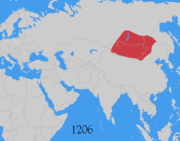
In the chaos of the late twelfth century, a chieftain named Temüjin finally succeeded in uniting the Mongol tribes between Manchuria and the Altai Mountains. In 1206, he took the title Genghis Khan, and waged a series of military campaigns - renowned for their brutality and ferocity till today - sweeping through much of Asia, and forming the Mongol Empire, the largest contiguous land empire in world history. Under his successors it stretched from present-day Poland in the west to Korea in the east, and from Siberia in the north to the Gulf of Oman and Vietnam in the south, covering some 33,000,000 km² (12,741,000 sq mi), (22% of Earth's total land area) and having a population of over 100 million people.
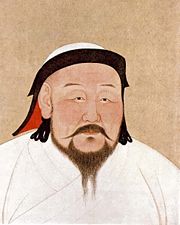
After Genghis Khan's death, the empire had been subdivided into four kingdoms or Khanates which eventually split-up after Möngke's death in 1259. One of the khanates, the "Great Khanate", consisting of the Mongol homeland and China, became the Yuan Dynasty under Kublai Khan, grandson of Genghis Khan. He set up his capital in present day Beijing but after more than a century of power, the Yuan was replaced by the Ming Dynasty in 1368, with the Mongol court fleeing to the north. As the Ming armies pursued the Mongols into their homeland, they successfully sacked and destroyed the Mongol capital Karakorum among other cities, wiping out the cultural progress that was achieved during the imperial period and thus throwing Mongolia back to anarchy.
Post-Imperial period
The next centuries were marked by violent power struggles between various factions, notably the Genghisids and the non-Genghisid Oirads and numerous Chinese invasions (like the five expeditions led by the Yongle Emperor). In the early 15th century, the Oirads under Esen Tayisi gained the upper hand, and even raided China in 1449 in a conflict over Esen's right to pay tribute, capturing the Chinese emperor in the process. However, Esen was murdered in 1454, and the Genghisids recovered. In the mid-16th century, Altan Khan of the Tümed, a grandson of Batumöngke - but no legitimate Khan himself - became powerful. He founded Hohhot in 1557 and his meeting with the Dalai Lama in 1578 sparked the second introduction of Tibetan Buddhism to Mongolia. Abtai Khan of the Khalkha converted to buddhism in 1585 and founded the Erdene Zuu monastery in 1586. His grandson Zanabazar became the first Jebtsundamba Khutughtu in 1640.
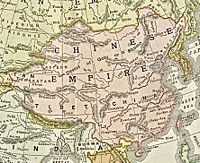
The last Mongol Khan was Ligden Khan in the early 17th century. He got into conflicts with the Manchu over the looting of Chinese cities, and managed to alienate most Mongol tribes. He died in 1634 on his way to Tibet, in an attempt to evade the Manchu and destroy the Yellow Church. By 1636, most Inner Mongolian tribes had submitted to the Manchu. The Khalkha eventually submitted to the Qing in 1691, thus bringing all but the west of today's Mongolia under Beijing's rule. After several wars, the Dzungars were virtually annihilated in 1757. Until 1911, the Manchu maintained control of Mongolia with a series of alliances and intermarriages, as well as military and economic measures. Ambans, Manchu "high officials", were installed in Khüree, Uliastai, and Khovd, and the country was subdivided into ever more feudal and ecclesiastical fiefdoms. Over the course of the 19th century, the feudal lords attached more importance to representation and less importance to the responsibilities towards their subjects. In addition the usurous practices of the Chinese traders, along with the collection of imperial taxes in silver instead of animals, resulted in poverty becoming rampant.
Independence
With the fall of the Qing Dynasty, Mongolia declared independence in 1911. The new country's territory was approximately that of the former Outer Mongolia. To no avail the 49 hoshuns of Inner Mongolia as well as the Mongolians of the Alashan and Qinghai regions expressed their willingness to join the nascent state. In 1919, after the October Revolution in Russia, Chinese troops led by Xu Shuzheng occupied the capital but their dominance was short-lived. The notorious Russian adventurer "Bloody" Baron Ungern who had fought with the " Whites" against the Red Army in Siberia, led his troops into Mongolia, triumphing over Chinese in Niislel Khüree. He ruled briefly, under the blessing of religious leader Bogd Khan before he was captured and executed by the Red Army assisted by Mongolian units led by Damdin Sükhbaatar. These events led to abolition of the feudal system and ensured the country's political alignment with Bolshevik Russia.
Mongolian People's Republic
In 1924, after the death of the religious leader and king Bogd Khan, a Mongolian People's Republic was proclaimed with support from the Soviets.
In 1928, Khorloogiin Choibalsan rose to power. He instituted collectivisation of livestock, the destruction of Buddhist monasteries and the Mongolia's enemies of the people persecution resulting in the murder of monks and other people. The Stalinist purges beginning in 1937, affected the Republic as it left more than 30,000 people dead. Japanese imperialism became even more alarming after the invasion of neighboring Manchuria in 1931. During the Soviet-Japanese Border War of 1939, the USSR successfully defended Mongolia against Japanese expansionism. In August 1945 Mongolian forces also took part in the Soviet offensive in Inner Mongolia . The Soviet threat of seizing parts of Inner Mongolia induced the Republic of China to recognize Outer Mongolia's independence, provided that a referendum was held. The referendum took place on October 20, 1945, with (according to official numbers) 100% of the electorate voting for independence. After the establishment of the People's Republic of China, both countries recognized each other again on October 6, 1949.
In January 26, 1952, Yumjaagiin Tsedenbal took power. In 1956 and again in 1962, Choibalsan's personality cult was condemned. Mongolia continued to align itself closely with the Soviet Union, especially after the Sino-Soviet split of the late 1950s. While Tsedenbal was visiting Moscow in August 1984, his severe illness prompted the parliament to announce his retirement and replace him with Jambyn Batmönkh.
Democracy
The introduction of perestroika and glasnost in the USSR by Mikhail Gorbachev strongly influenced Mongolian politics leading to the peaceful Democratic Revolution of 1990. This, in turn, allowed the country to begin engaging in economic and diplomatic relations with the Western world. The nation finished its transition from a communist state to a multi-party capitalist democracy with the ratification of a new constitution in 1992.
Government and politics
Mongolia is a parliamentary republic. The parliament is elected by the people and in turn elects the government. The president is elected directly. Mongolia's constitution guarantees full freedom of expression, religion, and others. Mongolia has a number of political parties, the biggest ones being the Mongolian People's Revolutionary Party (MPRP) and the Democratic Party (DP).
The MPRP formed the government of the country from 1921 to 1996 (until 1990 in a one-party system) and from 2000 to 2004. From 2004 to 2006, it was part of a coalition with the DP and two other parties, and since 2006 it has been the dominant party in two other coalitions. Both changes of government after 2004 were initiated by the MPRP. The DP was the dominant force in the ruling coalition between 1996 and 2000, and also an approximately equal partner with the MPRP in the 2004-2006 coalition. The next parliamentary elections are set for June 2008.
President
Mongolia's president has a symbolic role, but can block the parliament's decisions, who can then overrule the veto by a 2/3 majority. Mongolia's Constitution provides three requirements for taking office as President: the individual must be a native-born Mongolian, be at least 45 years of age, and have resided in Mongolia for five years prior to taking office. The current President is Nambaryn Enkhbayar.
The State Great Khural
Mongolia uses a unicameral parliamentary system in which the president has a symbolic role and the government chosen by the legislature exercises executive power. The legislative arm, the State Great Khural, has one chamber with 76 seats and is chaired by the speaker of the house. It elects its members every four years by general elections. The State Great Khural is powerful in the Mongolian government with the president being largely symbolic and the prime minister being confirmed from the parliament.
Prime Minister and the Cabinet
The Prime Minister of Mongolia is elected by the State Great Khural. The current prime minister is Sanjaagiin Bayar, who was elected by sixty-seven votes to two on November 22, 2007. The deputy prime minister is Miyeegombyn Enkhbold (since December 5, 2007). There are ministers of each department (finance, defense, labor, agriculture, etc.) and those offices constitute the prime minister's cabinet.
The cabinet is nominated by the prime minister in consultation with the president and confirmed by the State Great Khural.
Foreign relations and military
Mongolia maintains positive relations and has diplomatic missions with many countries such as the United States, Russia, North and South Korea, Japan, and the People's Republic of China. The government has focused a great deal on encouraging foreign investments and trade. Mongolia supported the 2003 invasion of Iraq, and has sent several successive contingents of 103 to 180 troops each to Iraq. Smaller contingents were also sent to Afghanistan. 200 Mongolian troops are serving in Sierra Leone on a UN mandate to protect the UN's special court set up there. From 2005 to 2006, about 40 troops were deployed with the Belgian and Luxembourgish contingent in Kosovo. On November 21, 2005, George W. Bush became the first-ever sitting U.S. President to visit Mongolia. In 2004, under the Bulgarian chairmanship, The Organisation for Security and Cooperation in Europe (OSCE), invited Mongolia as its newest Asian Partner.
Mongolia has embassies in Almaty, Ankara, Bangkok, Berlin, Beijing, Brussels, Budapest, Cairo, Warsaw, Washington, D.C., Vienna, Vientiane, Havana, Delhi, London, Moscow, Ottawa, Paris, Prague, Pyongyang, Seoul, Sofia, Tokyo, Hanoi, and Singapore, a consulate in Irkutsk and Ulan-Ude, and a diplomatic mission to the United Nations in New York City and to the European Union in Geneva.
Geography and climate
At 1,564,116 km² (603,909 mi²), Mongolia is the world's nineteenth-largest country (after Iran). It is significantly larger than the next-largest country, Peru.
The geography of Mongolia is varied with the Gobi desert to the south and with cold and mountainous regions to the north and west. Mongolia consists of relatively flat steppes. The highest point in Mongolia is the Khüiten Peak in the Tavan bogd massif in the far west at 4,374 m (14,350 ft). The basin of the lake Uvs Nuur, shared with Tuva Republic in Russia, is a natural World Heritage Site.
Most of the country is hot in the summer and extremely cold in the winter, with January averages dropping as low as -30°C (-22°F). The country is also subject to occasional harsh climatic conditions known as zud. Ulan Bator has the lowest average temperature of any national capital in the world. Mongolia is high, cold, and windy. It has an extreme continental climate with long, cold winters and short summers, during which most of its annual precipitation falls. The country averages 257 cloudless days a year, and it is usually at the centre of a region of high atmospheric pressure. Precipitation is highest in the north (average of 20 to 35 centimeters per year) and lowest in the south, which receives 10 to 20 centimeters annually. The extreme south is the Gobi, some regions of which receive no precipitation at all in most years.
The name "Gobi" is a Mongol term for a desert steppe, which usually refers to a category of arid rangeland with insufficient vegetation to support marmots but with enough to support camels. Mongols distinguish Gobi from desert proper, although the distinction is not always apparent to outsiders unfamiliar with the Mongolian landscape. Gobi rangelands are fragile and are easily destroyed by overgrazing, which results in expansion of the true desert, a stony waste where not even Bactrian camels can survive.
Aimags and sums
Mongolia is divided into 21 aimags ( provinces), which are in turn divided into 315 sums ( districts). The capital Ulan Bator is administrated separately as a khot ( municipality) with provincial status. The aimags are:
|
|
|
Economy
Mongolia's economy is centered on agriculture and mining. Mongolia has rich mineral resources, and copper, coal, molybdenum, tin, tungsten, and gold account for a large part of industrial production.
There are currently over 30,000 independent businesses in Mongolia, chiefly centered around the capital city. The majority of the population outside urban areas participate in subsistence herding; livestock typically consists of sheep, goats, cattle, horses, and Bactrian camels. Agricultural crops include wheat, barley, potato, vegetables, tomato, watermelon, sea-buckthorn and fodder crops. GDP per capita in 2006 was $2,100. Although GDP has risen steadily since 2002 at the rate of 7.5% in an official 2006 estimate, the state is still working to overcome a sizable trade deficit. A massive ($11 billion) foreign debt to Russia was settled by the Mongolian government in 2004 with a $250 million payment. Despite growth, the proportion of the population below the poverty line is estimated to be 35.6% in 1998, 36.1% in 2002-2003, 32.2% in 2006, and both the unemployment rate and inflation rate are relatively high at 3.2% and 6.0%, respectively (in 2006)
The Mongolian Stock Exchange, established in 1991 in Ulan Bator, is the world's smallest stock exchange by market capitalisation.
Industrial sector
Industry currently accounts for 21.4% of GDP, approximately equal to the weight of the agriculture sector (20.4%). These industries include construction materials, mining (coal, copper, molybdenum, fluorspar, tin, tungsten, and gold), oil, food and beverages, processing of animal products, and cashmere and natural fibre manufacturing. The industrial production growth rate is estimated to be 4.1% in 2002. Mining is continuing to rise as a major industry of Mongolia as evidenced by number of Chinese, Russian and Canadian firms opening and starting mining business in Mongolia. Domestic food production, especially packaged food production has been increasingly coming up with speed with investments from foreign companies.
Science and technology
Some technology companies from nearby countries, such as South Korea and the People's Republic of China, have started to open offices in Mongolia. Those companies have tended to focus on software development rather than hardware production. A number of telecommunications companies and internet service providers have been established resulting in greater competition in the internet and phone market, especially in cell phones.
Service sector
After the transition shocks of the early 1990s, Mongolian domestic production has picked up again. According to the CIA World Factbook, in 2003, the service sector accounted for 58% of the GDP, with 29% of the labor force of 1.488 million involved.
Foreign investment from other countries (including China, Japan, South Korea, Germany and Russia) has helped to add more paved roads. The most important is a 1000 km north-south road leading from the Russian border at Sükhbaatar to the Chinese border at Zamyn-Üüd. There are several air transport companies in Mongolia, including MIAT, Aero Mongolia, and Eznis Airways.
Petroleum products are mainly (80%) imported from Russia, which makes Mongolia vulnerable to supply side shocks. This is one strong example of the influence of Mongolia's neighbors on its economy.


